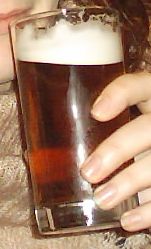Science News
Beer!
April 1, 2011

To celebrate the opening day of baseball, the beautiful Bay Area weather and the end of the drought here in California, today we’ll raise a pint to the science of beer!
Earlier this week, Scientific American wrote about the mystery of the origin of beer. Apparently, previous scientific papers published on this delicious drink push back its origin several thousand years, but it could go back much farther:
The various lines of evidence indicate that beer may well be as old as cooking itself, which began at least 250,000 years ago. "When people started harnessing fire and cooking, they probably started making beer," [UC Berkeley’s Christine] Hastorf said.
Earlier this year, Science News also offered an article about ancient beer. It stated that:
The oldest known beer residue and brewing facilities date to 5,500 years ago in the Middle East, but archaeological clues to beer’s history are rare.
Focusing on 2500-year-old Celtic beer, it describes the taste, recipe and brewing process of this cloudy, yeasty, smelly, warm beer. Gulp!
If you want to brew that concoction or perhaps something a little tastier, Wired offers a “High-Tech Home Brew Kit Would Make Beer Robot Swoon” today.
If bubbles are what you want (think stout beers), Science News published a piece on St. Patrick’s Day (fittingly) on the physics of bubble forming and creating better brews.
If you simply want to dive deeper into the chemistry of beer, Carl Zimmer, science writer and microbe fan, spoke with Anheuser-Busch Endowed Professor (nice title, right?) Charles Bamforth, PhD of UC Davis late last year about beer “and the pivotal role microbes play in making it happen” in this podcast.
Too early for a beer? How about a Bloody Mary? On Tuesday, at the American Chemical Society meeting, scientists presented the flavor chemistry of the "Bloody Mary" cocktail:
Each of the main ingredients has been shown to contain many flavor components, thus indicating that a Bloody Mary cocktail flavor is a very complex blend of several hundred flavor compounds. These include semi- and non-volatile ingredients with chemesthetic effects such a heat, burn, sour, salty and umami.
You can learn more in a podcast from Scientific American.
Cheers!
Image courtesy of SilkTork/Wikimedia